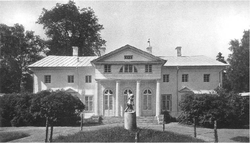Pokrovskoye-Streshnevo Estate
It has a manor house in the classicism style, a church [ru] from the 17th century, and other various Russian Revival architecture buildings.
In the Middle Ages, on the site of the current estate, there was a village named Podjolki (Russian: Подъёлки).
He eventually became a law-abiding citizen, advanced in the military, became a voivode in Мurom and in 1622 he sold Podjolki to the diak Mikhail Feofilatievich Danilov.
Rodion Streshnev served the first four tsars of the Romanov dynasty and from the late 1670s he was the tutor of Peter the Great.
After the purchase of Pokrovskoye, Rodion Streshnev did not particularly rebuild the village: he simply installed a “boyar court”, and several economic services.
Starting in 1664, the estate was in the hands of the descendants of Rodion Streshnev for two and a half centuries, passing through six generations.
Pyotr Streshnev's children died in infancy or in early childhood, so in 1750 he vowed to revive the estate's church in order to beg for another child.
In 1766, a stone manor house was built in the Elizabethan Baroque style with a suite of 10 front rooms and a collection of more than 130 paintings.
Although Pyotr fulfilled all the whims of his daughter, he opposed her desire to marry a widower with a child, Fyodor Ivanovich Glebov.
A verst from the estate, on the banks of a river, Fyodor Glebov built an elegant two-story bathroom house, named "Yelizavetino."
In the main manor house, on the walls of the front rooms, the coats of arms of the Streshnevs and Glebovs were hung up.
She was known in society as an educated woman, and the house had a good library and modern technical innovations such as a telescope and a microscope.
In his book “Old Estates: Essays on the History of Russian Noble Culture”, one of the most famous art historians of the early 20th century, Nikolai Wrangel [ru], wrote about Pokrovskoye-Streshnev.
Other buildings were added in 1883, some of them in the form of stylized castle turrets (the northeastern octagonal tower was designed in 1893 by Fyodor Kolbe [ru]).
From 1889-1890, according to the notes of the architects Fyodor Kolbe and Aleksander Popov [ru],[1] a Russian style stone fence with red brick towers was built around the estate.
She owned Villa San Donato in Italy, a yacht in the Mediterranean, and a railroad carriage to travel south.
In 1897, Sophia Tolstaya complained in a letter to her husband: "In Pokrovskoye, it is very sad that the anger of the hostess is visible everywhere: everything is fenced with barbed wire, evil watchmen are everywhere, and you can only walk along dusty, high roads.
In the 1910s, as evidenced by materials from the Shakhovsky-Glebov-Streshnev family archive in the State Historical Museum, Yevgenia Shakhovskaya-Glebova-Streshneva made many changes in the estate.
In 1912, a large amount of family jewels were stolen from the estate, including the “pink diamond” that belonged first to the Romanovs.
At the beginning of the 19th century, on the opposite side of the road from Vsekhsvyatskoye to Tushino (where the Volokolamsk highway is currently) a settlement of 22 dachas were built.
At the beginning of the 20th century, cottages were rented from 100 to 2000 rubles per season and were so popular that in the summer of 1908 a bus service was arranged between Pokrovskoye and Petrovsky-Razumovsky (along the Petersburg highway).
[3] After the revolution, the estate, together with the many dachas, were requisitioned and turned into a sanatorium for the Central Committee, and the Yelizavetino bathroom house was transferred to a textile workers' rest home.
It was widely thought that an attempt was made to open the museum in 1925, but for various reasons (lack of funding, poor exposure) it was soon closed and ruined.
In winter, the estate archive was dismantled and it was eventually put in the Department of Written Sources in the State Historical Museum.
After the closing of the museum, the Institute of Higher Nervous Activity and Neurophysiology was located the estate for some time.
Mikhail Bulgakov wrote in his diary on September 2, 1923: “Today I went with Kataev to the dacha of Alexei Tolstoy (Ivankovo).
At the same time, the restoration of the estate buildings began: the main house, the fence, and the corner tower, part of which collapsed in the winter of 1983-1984 were worked on.
However, in 2006, the Property Management Agency filed a lawsuit against Aeroflot and StroyArsenal to declare the sale and purchase of this territory invalid.
[5] At the end of 2012, the estate was transferred to the Higher School of Economics, but restoration work did not begin, since a judicial arrest was imposed on the disputed property.
The northwestern natural boundary of the park is the Khimka River [ru], the only clean source of drinking water in Moscow as of 2009.






